 State park rangers wear many hats
By BOB GWIZDZ
Michigan Department of Natural Resources
Two days of high winds – followed by a day-long, sometimes intense rain – completely changed Scott Slavin’s plans.
The unit manager for the Michigan Department of Natural Resources’ William Mitchell State Park and the White Pine Trail in Wexford County, Slavin thought the snowshoe/fat-tire bicycle portion of the trail could use a good grooming.
But the rain wiped out most of the snow, so Slavin shifted gears. Instead, he decided he’d spend the morning checking for fallen trees at a couple of nearby state forest campgrounds.
Slavin – who was working alone, as the rest of the staff at his headquarters at Mitchell State Park was either on vacation or seasonal lay-off – loaded a chain saw into the back of his truck and headed out.
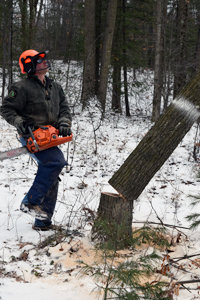 He checked a couple of state forest campgrounds and there were no fallen trees on the roads. Still, there were several standing dead trees that had been deemed hazardous – including some hardwoods that had succumbed to oak wilt – and Slavin figured, as long as I’m out here…
He cut down a few of the oaks that needed to be removed before spring camping season gets underway. For Slavin, it’s all in a day’s work. There’s no such thing as a typical day, he said.
“You can go from working on bathroom plumbing to writing a ticket to arresting someone to cutting a tree down,” he said. “I’ve had those days before.”
Slavin, who worked for seven years as a park ranger prior to becoming a unit manager, is commissioned as a peace officer. He said most of his arrests occurred when he worked in southeastern Michigan earlier in his career.
|
“Most of the time it’s people who have (outstanding) warrants,” he said. “If you’re writing them a citation for something and you call in and see that they have a warrant, you hold them until the police department can come get them. When I worked in southern Michigan it happened quite often.”
Slavin said that about half of a ‘typical day’ during spring, summer and fall involves interacting with the public – everything from answering telephone calls to solving problems at campgrounds.
“Dealing with health and safety issues is our No. 1 priority,” he said. “If we get storms or there’s a damaged facility – like an unsafe boat dock – we get right on it. And we do interpretive programs as well.”
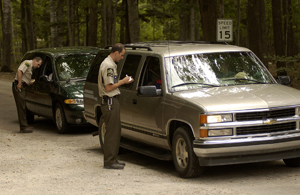 During the winter, Slavin said a lot of his work involves long-term planning and meeting with workers to make sure the work gets done.
“My job changes a lot.”
As do those of other park rangers.
“A park ranger is a lot of things in our system,” said Ron Olson, chief of the DNR’s Parks and Recreation Division. “They’re law enforcement, they’re customer service representatives, they are maintenance and operations staff.
“As one of our district supervisors says, ‘they’re the Yellow Pages of doers.’”
|
 The DNR has a total of 325 park rangers, 87 full-timers and 238 part-time or seasonal rangers.
“Park rangers vary from entry-level rangers up to the commissioned rangers who go to law enforcement school and take a five-week course,” Olson said. “They can issue tickets and citations; it’s certainly short of a conservation officer, but they are credentialed.”
Rangers work with park supervisors to determine day-to-day activities, Olson said, but assignments are tailored to take advantage of an individual’s skill set.
“Each park has a set of basic activities, but if one has a particular knack for carpentry, for instance, he may be called on to do different work than some who don’t,” he said.
|
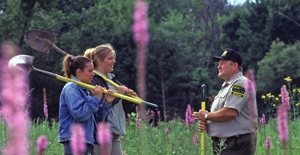 Park rangers often greet the public and provide guidance about a park’s amenities. They resolve conflicts for everything from visitors with unleashed dogs to excessive noise complaints to dealing with unacceptable behavior associated with alcohol.
“It’s not just about writing tickets,” Olson said. “It’s making sure someone’s behavior doesn’t necessarily impact someone else’s experience at the park.”
Rangers work regularly with area friends’ groups to help generate park improvements to make sure permitted activities – such as trail races – run smoothly and safely.
“Some parks have more rangers than others, depending on the size of the park and intensity of activities,” Olson said. “Some parks don’t have any.”
|
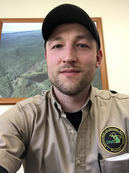 But they all wear many hats.
“No two days are alike – that’s the beauty of the job,” said Michael Knack, who recently became a park supervisor – after four years as a lead ranger and nine years as a ranger – at Porcupine Mountains State Park in Ontonagon and Gogebic counties.
“Every day is an adventure – or you get to choose your own adventure. You start your day with a plan. But life happens in the park and your plan can go many directions,” he said. “I may be sitting in the office, then get called on to take care of a tree that’s fallen across the road or field a complaint about a bear getting into someone’s cooler or a trash can.”
Rangers at the Porkies use boats almost daily during the summer to get to some of the historic cabins at the park.
|
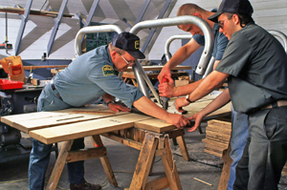 “Then we get out with a chainsaw and cut the trail to the log cabin and then work on the cabins that have been around for 70 years,” Knack said.
In the winter, the rangers are often out grooming the 42 kilometers of cross-country ski trails, helping at the ski lift or hauling firewood to the cabins.
“We’re busy every day,” Knack said. “There’s not a lot of law enforcement here, but we respond fairly regularly for search and rescue of lost hikers. Some are overnighters.”
At the Waterloo State Recreation Area in Jackson and Washtenaw counties, park ranger Matt Schweda said he has a routine, but it’s often interrupted.
“A typical day in the summertime, we check the campgrounds, register new campers, talk to campers and see if there are any complaints, pick up trash, clean the vault toilets,” he said. “Then they check boat launch sites – check for litter or problems, check for Recreation Passports at the boat launches. When I worked the night shift I checked for illegal camping at the boat access sites.
|
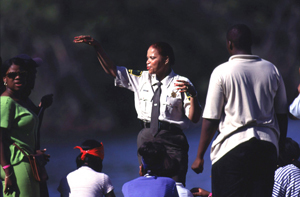 “It’s a pretty revolving process. I’ve usually got two summer workers – sometimes they travel with me, sometimes we split up. Then in the afternoon we go through the campgrounds again.”
Schwada said part of the job is just being “a visible presence” at the area, especially on weekends.
“Things come up,” he said. “It could be a law enforcement situation; it could be a maintenance issue.”
Schweda, who studied heating and cooling while he was a summer worker for four seasons before he became a ranger, said his education has helped him immensely.
“I learned a lot about electricity and pipe-fitting,” he said. “It‘s helped me out a lot when I have to fix things.”
That’s a park ranger: a repairman, educator, information specialist and a cop. It’s no wonder they all say they love their jobs.
|
Get more information on parks at the DNR website at www.mi.gov/stateparks.
Check out previous Showcasing the DNR stories and subscribe to upcoming articles at www.michigan.gov/dnrstories.
/Note to editors: Contact: John Pepin 906-226-1352. Accompanying photos are available below for download and media use. Suggested captions follow. Credit: Michigan Department of Natural Resources, unless otherwise noted.
Beach: A park ranger interacts with visitors at Holland State Park in Ottawa County.
Camper: A ranger helps a first-time camper at the Pinckney Recreation Area, located northwest of Ann Arbor.
Knack: Michael Knack, park supervisor at Porcupine Mountains Wilderness State Park in Gogebic and Ontonagon counties.
Office: Rangers at work in the office at Leelanau State Park in Leelanau County.
Olson: Ron Olson, chief of the Michigan Department of Natural Resources’ Parks and Recreation Division.
Ranger: Michigan state park rangers perform a wide range of duties.
Registration: Campers register at Leelanau State Park in Leelanau County.
Riper: Park staff at work at Van Riper State Park in Marquette County.
Shovels: Two volunteers on a habitat project talk with a state park ranger.
Slavin: Scott Slavin, unit manager for William Mitchell State Park and the White Pine Trail in Wexford County, cuts down a tree.
Welcome: A park ranger welcomes a visitor to Dodge No. 4 State Park in Oakland County./
|